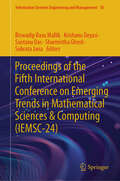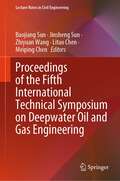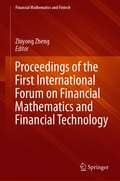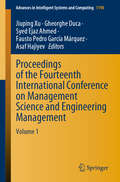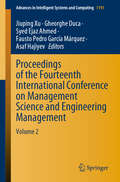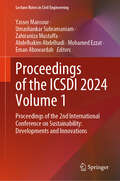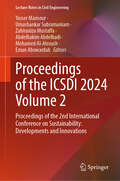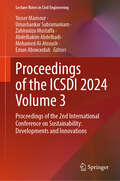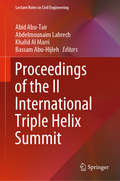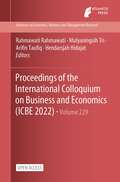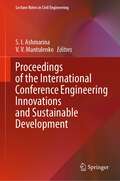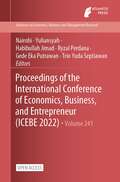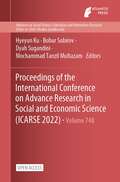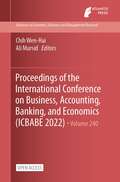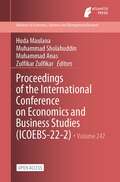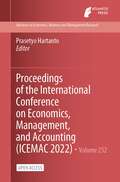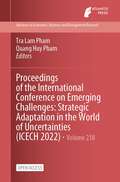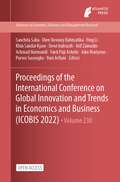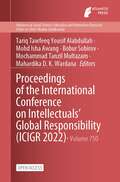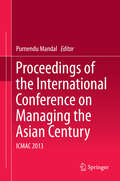- Table View
- List View
Proceedings of the Fifth International Conference on Emerging Trends in Mathematical Sciences & Computing (Information Systems Engineering and Management #10)
by Santanu Das Subrata Jana Sharmistha Ghosh Krishanu Deyasi Biswadip Basu MallikThe Proceedings of the Fifth International Conference on Emerging Trends in Mathematical Sciences & Computing (IEMSC-24) contains papers that present the current scientific as well as technological innovations by leading academicians, eminent researchers, and experts throughout the globe in the twin domain of Mathematical Sciences as well as Computing. The papers focus on the recent advances in the field of Theoretical Computer Science as well as its blending with Mathematical techniques. The book aims to disseminate new technical ideas and features that can be incorporated in day-to-day life for the benefit of the society. The research papers exhibit scientific advancements in diversified spectrum that includes Differential as well as Integral Equations with applications, Computational Fluid Dynamics, Nanofluids, Network Theory & Optimization, Control Theory, Machine Learning & Artificial Intelligence, Big Data Analytics, IoT, Cryptography, Fuzzy Automata, Statistics, and many more. The proceedings primarily focus on the amalgamation of mathematical methods with computing. The potential readers will get access to diverse ideas and innovations in the field of computing together with its growing interactions in various fields of mathematics. This book serves as a valuable reference resource for researchers in academia and industry.
Proceedings of the Fifth International Technical Symposium on Deepwater Oil and Gas Engineering (Lecture Notes in Civil Engineering #472)
by Baojiang Sun Zhiyuan Wang Jinsheng Sun Litao Chen Meiping ChenThis book is a compilation of selected papers from the Fifth International Technical Symposium on Deepwater Oil and Gas Engineering and the Fourth International Youth Forum on Gas Hydrate (DWOG-Hyd 2023), held in Qingdao, China, in October 2023. The book focuses on the advancement of techniques for the deepwater oil and gas exploitation and natural gas hydrate exploitation. The book introduces new ideas for exploring deepwater oil, gas and hydrate in a safe and efficient way. Advances of the deepwater oil, gas and hydrate drilling and production in South China Sea, in oil and gas flow assurance and emerging technologies based on clathrate hydrate will be presented. It is a valuable resource for both practitioners and academics working in the field of deepwater oil and gas engineering.
Proceedings of the First International Forum on Financial Mathematics and Financial Technology (Financial Mathematics and Fintech)
by Zhiyong ZhengThis book contains high-quality papers presented at the First International Forum on Financial Mathematics and Financial Technology. With the rapid development of FinTech, the in-depth integration between mathematics, finance and advanced technology is the general trend. This book focuses on selected aspects of the current and upcoming trends in FinTech. In detail, the included scientific papers focus on financial mathematics and FinTech, presenting the innovative mathematical models and state-of-the-art technologies such as deep learning, with the aim to improve our financial analysis and decision-making and enhance the quality of financial services and risk control. The variety of the papers delivers added value for both scholars and practitioners where they will find perfect integration of elegant mathematical models and up-to-date data mining technologies in financial market analysis.
Proceedings of the Fourteenth International Conference on Management Science and Engineering Management: Volume 1 (Advances in Intelligent Systems and Computing #1190)
by Fausto Pedro García Márquez Jiuping Xu Gheorghe Duca Asaf Hajiyev Syed Ejaz AhmedThis book gathers the proceedings of the 14th International Conference on Management Science and Engineering Management (ICMSEM 2020). Held at the Academy of Studies of Moldova from July 30 to August 2, 2020, the conference provided a platform for researchers and practitioners in the field to share their ideas and experiences.Covering a wide range of topics, including hot management issues in engineering science, the book presents novel ideas and the latest research advances in the area of management science and engineering management. It includes both theoretical and practical studies of management science applied in computing methodology, highlighting advanced management concepts, and computing technologies for decision-making problems involving large, uncertain and unstructured data. The book also describes the changes and challenges relating to decision-making procedures at the dawn of the big data era, and discusses new technologies for analysis, capture, search, sharing, storage, transfer and visualization, and in the context of privacy violations, as well as advances in the integration of optimization, statistics and data mining. Given its scope, it will appeal to a wide readership, particularly those looking for new ideas and research directions.
Proceedings of the Fourteenth International Conference on Management Science and Engineering Management: Volume 2 (Advances in Intelligent Systems and Computing #1191)
by Fausto Pedro García Márquez Jiuping Xu Gheorghe Duca Asaf Hajiyev Syed Ejaz AhmedThis book gathers the proceedings of the 14th International Conference on Management Science and Engineering Management (ICMSEM 2020). Held at the Academy of Studies of Moldova from July 30 to August 2, 2020, the conference provided a platform for researchers and practitioners in the field to share their ideas and experiences.Covering a wide range of topics, including hot management issues in engineering science, the book presents novel ideas and the latest research advances in the area of management science and engineering management. It includes both theoretical and practical studies of management science applied in computing methodology, highlighting advanced management concepts, and computing technologies for decision-making problems involving large, uncertain and unstructured data. The book also describes the changes and challenges relating to decision-making procedures at the dawn of the big data era, and discusses new technologies for analysis, capture, search, sharing, storage, transfer and visualization, as well as advances in the integration of optimization, statistics and data mining. Given its scope, it will appeal to a wide readership, particularly those looking for new ideas and research directions.
Proceedings of the ICSDI 2024 Volume 1: Proceedings of the 2nd International Conference on Sustainability: Developments and Innovations (Lecture Notes in Civil Engineering #556)
by Umashankar Subramaniam Yasser Mansour Zahiraniza Mustaffa Abdelhakim Abdelhadi Eman Abowardah Mohamed EzzatThis book offers a comprehensive overview of the latest research, innovations, and practical applications in the field of sustainability, with a focus on construction materials and their use in building and civil engineering structures. As an outcome of the 2nd International Conference on Sustainability: Developments and Innovations (ICSDI 2024), the book presents a selection of peer-reviewed papers from prominent researchers and engineers around the world. The book covers a broad range of topics, including construction and resilient infrastructure, sustainable manufacturing, industrial ecology, renewable energy, future cities, sustainable built environment design, and policies, regulations, and economics for achieving sustainable development goals. This book will serve as an essential reference for graduate students, engineers, and scientists, as well as industry professionals working in the field of sustainability. The book aligns with the scope of book series scope which aims tocontribute to progress in the construction sciences, techniques, and industries through communication between research and practice. It is also a valuable resource for practitioners and policymakers who are interested in understanding the latest technological advancements and innovations in sustainability to solve real-world problems.
Proceedings of the ICSDI 2024 Volume 2: Proceedings of the 2nd International Conference on Sustainability: Developments and Innovations (Lecture Notes in Civil Engineering #557)
by Umashankar Subramaniam Yasser Mansour Zahiraniza Mustaffa Abdelhakim Abdelhadi Mohamed Al-Atroush Eman AbowardahThis book offers a comprehensive overview of the latest research, innovations, and practical applications in the field of sustainability, with a focus on construction materials and their use in building and civil engineering structures. As an outcome of the 2nd International Conference on Sustainability: Developments and Innovations (ICSDI 2024), the book presents a selection of peer-reviewed papers from prominent researchers and engineers around the world. The book covers a broad range of topics, including construction and resilient infrastructure, sustainable manufacturing, industrial ecology, renewable energy, future cities, sustainable built environment design, and policies, regulations, and economics for achieving sustainable development goals. This book will serve as an essential reference for graduate students, engineers, and scientists, as well as industry professionals working in the field of sustainability. The book aligns with the scope of book series scope which aims tocontribute to progress in the construction sciences, techniques, and industries through communication between research and practice. It is also a valuable resource for practitioners and policymakers who are interested in understanding the latest technological advancements and innovations in sustainability to solve real-world problems.
Proceedings of the ICSDI 2024 Volume 3: Proceedings of the 2nd International Conference on Sustainability: Developments and Innovations (Lecture Notes in Civil Engineering #558)
by Umashankar Subramaniam Yasser Mansour Zahiraniza Mustaffa Abdelhakim Abdelhadi Mohamed Al-Atroush Eman AbowardahThis book offers a comprehensive overview of the latest research, innovations, and practical applications in the field of sustainability, with a focus on construction materials and their use in building and civil engineering structures. As an outcome of the 2nd International Conference on Sustainability: Developments and Innovations (ICSDI 2024), the book presents a selection of peer-reviewed papers from prominent researchers and engineers around the world. The book covers a broad range of topics, including construction and resilient infrastructure, sustainable manufacturing, industrial ecology, renewable energy, future cities, sustainable built environment design, and policies, regulations, and economics for achieving sustainable development goals. This book will serve as an essential reference for graduate students, engineers, and scientists, as well as industry professionals working in the field of sustainability. The book aligns with the scope of book series scope which aims tocontribute to progress in the construction sciences, techniques, and industries through communication between research and practice. It is also a valuable resource for practitioners and policymakers who are interested in understanding the latest technological advancements and innovations in sustainability to solve real-world problems.
Proceedings of the II International Triple Helix Summit (Lecture Notes in Civil Engineering #43)
by Abid Abu-Tair Abdelmounaim Lahrech Khalid Al Marri Bassam Abu-HijlehThis volume gathers the latest advances and innovations in the triple helix of university-industry-government relations, as presented by leading international researchers at the II International Triple Helix Summit 2018, held in Dubai, UAE on November 10-13, 2018, which brought together experts, practitioners and academics across disciplines that address the dynamics of government, industry and academia. It covers analysis, theory, measurements and empirical enquiry in all aspects of university-industry-government interactions, as well as the international bases and dimensions of triple helix relations, their impacts, and social, economic, political, cultural, health and environmental implications. It also examines the role of government/academia/industry in building innovation-based cities and nations, and in transforming nations into knowledge-based sustainable economies. The contributions, which were selected by means of a rigorous international peer-review process, highlight numerous exciting ideas that will spur novel research directions and foster multidisciplinary collaboration among different specialists.
Proceedings of the International Academic Conference on Tourism (Advances in Social Science, Education and Humanities Research #699)
by Hera Oktadiana Janianton Damanik Badaruddin Mohammed Dyah Widyastuti Nuryuda IrdanaThis is an open access book. This international conference aims to discuss and provide critical views based on empirical experience and the relevant concepts to the changing trends and future directions of tourism development after the Covid-19 pandemic. Some of the topics that can be raised as discussion material include (but are not limited to): Adaptation strategies of tourism transportation modes to the CHSE standard Adaptation strategies and models of the tourism accommodation industry to the CHSE standard Creative Industry and tourism MSME business models in the post-pandemic period Reactivation and revitalization of community-based tourism businesses Optimizing the use of IT products in tourism business management Innovation and implementation of carbon neutral and green zones in tourism destinations Trends in travel financing planning changes Issues of de-skilling, recharging, and up-skilling tourism HR The future of tourism education institutions Reconstruction of tourism institutions in the post-pandemic period Relations between tourists and tourists in tourism destinations in the post-pandemic period Changes in tourist market profiles and preferences and their implications for promotion and marketing strategies Tourist perspectives on post-pandemic tourism and CHSE practices Trends and prospects for healthy tourism and green tourismThis is an open access book.This is an open access book.
Proceedings of the International Colloquium in Textile Engineering, Fashion, Apparel and Design 2014 (ICTEFAD #2014)
by Mohd Rozi Ahmad Mohamad Faizul YahyaThe book is a collection of academic papers from a conference that focuses on significant issues, fundamental and applied research advances on a range of topics in the areas of textile engineering, apparel, fashion and design. Among others, the book will update the readers on recent research in technical and functional textiles; future trends and visions for textile, apparel and fashion; global business, marketing and management in textile and apparel; education and training in textile and apparel and design, fashion, footwear product and materials innovation.
Proceedings of the International Colloquium on Business and Economics (Advances in Economics, Business and Management Research #666)
by Rahmawati Rahmawati Mulyaningsih Tri Arifin Taufiq Hendarsjah HidajatThis is an open access book. Doctoral Program of Economics and Business Faculty, UniversitasSebelas Maret organizes the 2022 International Colloquium onBusiness and Economics. The conference will be conducted bothonline and offline (hybrid) in Economic Faculty of UNS, Solo, onSeptember 27-28, 2022. In this conference, 30 papers were selectedfor international proceedings.Faculty of Economics and Business Universitas Sebelas Maret is one ofthe respectable Business School in Indonesia. In the recent releasefrom the Times Higher Education (THE), the faculty is categorized asTop 10 Economics and Business Faculty among hundreds University inIndonesia. Currently, our faculty have 3 undergraduate degrees, 3master’s degrees, and 1 doctoral degree program and all of them areaccredited with a rank “A”.
Proceedings of the International Conference Engineering Innovations and Sustainable Development (Lecture Notes in Civil Engineering #210)
by S. I. Ashmarina V. V. MantulenkoThis book contains contributions from the international conference “Engineering Innovations and Sustainable Development,” organized by three Russian universities on June 17–18, 2021. By presenting international research on various sustainability issues, it includes topics such as current trends in industrial and agricultural development, innovations in the construction and transport sectors, problems concerning the financing of innovative activities and governmental support for innovations, and engineering competences and skills in the era of new technologies. It also covers the economic, environmental, and informational aspects of sustainable development in the context of innovations. Finally, the book addresses theoretical and practical aspects by studying the phenomenon of sustainability and engineering development in terms of comparing international experiences. It provides significant value for scientists, teachers, and students of higher educational institutions, and specialists, who are researching sustainable development issues in the era of engineering innovations.
Proceedings of the International Conference of Economics, Business, and Entrepreneur (Advances in Economics, Business and Management Research #241)
by Ryzal Perdana Gede Eka Putrawan Trio Yuda Septiawan Nairobi Yuliansyah Habibullah JimadThis is an open access book.The Faculty of Economics and Business of Universitas Lampung in Indonesia is hosting the International Conference of Economics, Business & Entrepreneurship (ICEBE) 2022, its fifth annual international conference. The goal of this conference is to provide a clear direction and substantial advancements in the quickly recovering global economy. The 5th ICEBE welcomes and cordially encourages all authors to submit outstanding works on a range of topics relevant to the conference's theme.Theme: “Global Economy and Business Recovery Growth to Create a Sustainable Business-Friendly Environment”
Proceedings of the International Conference on Academia-Based Tourism Revival 2022 (Advances in Social Science, Education and Humanities Research #738)
by Dian Bayu Firmansyah Usep Muttaqin Ambhita Dhyaningrum Tri Wahyu Setiawan PrasetyoningsihThis is an open access book. ABTR 2022 is the first international conference on Academia-Based Tourism Revival initiated to generate a sort of a hybrid method proposed and tested in relation to the tourism revival process in Indonesia, especially in Banyumas, Central Java following the covid-19. This conference aims to generate collective ideas of researchers, practitioners and policy makers on the sound and strategic solutions to reinvent and revive the tourism sector in the post Covid-19 era in Banyumas, Central Java, Indonesia. This international conference is supported by experts from various universities: Mae Fah Luang University (Thailand), Lomonosov Moscow State University (Rusia), Universiti Kebangsaan Malaysia (Malaysia), Mariano Marcos State University (Philipines), Jamal Mohamed College (India). These universities have confirmed to send their delegations to participate in this conference as presenters.
Proceedings of the International Conference on Advance Research in Social and Economic Science (Advances in Social Science, Education and Humanities Research #748)
by Hyeyun Ku Bobur Sobirov Dyah Sugandini Mochammad Tanzil MultazamThis is an open access book.ThemeOptimizing the use of social science and economics in the post-pandemic revival eraThe Covid-19 pandemic is slowly starting to be overcome. Contributions from various disciplines are also needed in the context of post-pandemic recovery, including the fields of social science and economics. Thus, the International Conference on Advanced Research in Social and Economic Science is a forum for researchers and practitioners to exchange ideas and advances on how emerging research methods and sources are applied to various fields of the social sciences, as well as discuss current and future challenges. Join the social sciences conference as we explore the latest trends in social sciences and discuss common challenges in politics, social, communication, humanities, networking society, business, sustainable development, and international relations.
Proceedings of the International Conference on Business, Accounting, Banking, and Economics (Advances in Economics, Business and Management Research #240)
by Chih Wen-Hai Ali MursidThis is an open access book.Due to the impacts of the Coronavirus Disease (COVID-19) around the world, international conference will be held in Semarang, Central Java, Indonesia, on 9th November 2022. Will take place online via zoom. The BABE International Conference series is held at regular intervals to provide an interactive forum for presentation and discussion on the International Conference of Business, Accounting, Banking, and Economics Research. We welcome participants academicians and practitioners from all over the world who are interested in developing new knowledge and professional ties to enhance career opportunities. The BABE international conference should serve as an ideal forum to establish relationships among members around the world. We hope you will join us at the BABE international conference 2022 which will be held regularly every year.
Proceedings of the International Conference on Economics and Business Studies (Advances in Economics, Business and Management Research #247)
by Huda Maulana Muhammad Sholahuddin Muhammad Anas Zulfikar ZulfikarThis is an open access book.Universitas Muhammadiyah Surakarta proudly invite all students, researchers and academia to participate in the International Conference on Economics and Business Studies (ICOEBS).This conference is a part of a conference program called International Summit on Science Technology and Humanity (ISETH) 2022 Organized by Universitas Muhammadiyah Surakarta and will be held on 5-6 December 2022. This year's conference's theme is Green Business in Emerging Economies; Current Issues and Future Challenges.ICOEBS aims to provide opportunities for students, scholars and practitioners to present original research articles, unpublished research and novelties in Economics and Business studies. Full paper submission deadline is 8 November 2022.
Proceedings of the International Conference on Economics, Management, and Accounting (Advances in Economics, Business and Management Research #252)
by Prasetyo HartantoThis is an open access book.The International Conference on Economics, Management, and Accounting (ICEMAC) is an activity held at an international conference by presenting new studies and research results in the fields of Economics, Management, and Accounting. The Management and Accounting Study Program is the organizer of this international conference. ICEMAC is the third conference held by us and will be held virtually due to the COVID-19 Pandemic which has not shown a better situation. The 3rd ICEMAC 2022 conference will be expected to bring together national and international scale researchers, practitioners, students, and community and industry activists in our chosen fields. Considering the occurrence of disruptive technology in Indonesia which has an impact on business transformation in various fields, especially the accounting and economic fields which have changed massively into digitalization and put forward a new equilibrium or new balance. In order to move into the 5.0 era, the 3rd ICEMAC 2022 international conference has the main theme, namely“Sustainable business strategy to face challenges & Opportunity in digitalization era”.
Proceedings of the International Conference on Education, Humanities, and Management (Advances in Social Science, Education and Humanities Research #741)
by Yaoping Liu Saichol ChujuarjeenThis is an open access book. This event is co-organized by the Institute of Science Innovation and Culture (ISIC) and Research and Development Institute (RDI), Rajamangala University of Technology Krungthep, Thailand. This year’s ICEHUM 2022 was held online and onsite on 26 November 2022. The theme of this conference is “Leading and Being Sustainable in the COVID-19 New Normal“. This conference aspires to bring to light new standards, models, and reference guides that will help humanity rise above the challenges of COVID-19, leading men and women to embrace the new normal, no longer uncertain but living a sustainable existence.
Proceedings of the International Conference on Emerging Challenges: Strategic Adaptation in the World of Uncertainties (Advances in Economics, Business and Management Research #238)
by Tra Lam Pham Quang Huy PhamThis is an open access book.University of Economics Ho Chi Minh City, Hanoi University of Science and Technology – School of Economics and Management, University of Economics and Business - Vietnam National University, Hanoi, National Economics University – Faculty of Business and Management, The University of Danang – University of Economics, Vietnam National University – International School, Foreign Trade University, University of Hertfordshire (UK), AVSE Global (France) and PPM School of Management (Indonesia) will organize The 10th International Conference on Emerging Challenges: Strategic Adaptation in the World of Uncertainties (SAWU) in Ho Chi Minh City, Vietnam (online sessions available for international participants) on November 4-5, 2022. We would like to invite you to be a part of the ICECH2022 and submit your research papers for presentation consideration.The aim of ICECH2022 is to provide a forum for academics and professionals to share research findings, experiences and knowledge for adaptation and business strategy in a post-Covid as well as various uncertainties and complexities in the world in the Asia-Pacific region. We welcome the submissions in Economics, Business, Innovation Management, and Business Law.Authors of accepted papers will be invited to present their work at the Conference. In addition, authors of best papers will also be invited to submit their papers to a special issue or a regular issue for publication consideration in selected journals. These papers will also be under an official double-blind peer-reviewed process by the journal.
Proceedings of the International Conference on Emerging Trends in Business & Management (Advances in Economics, Business and Management Research #242)
by Sudarsan Jayasingh Kirubaharan Boobalan Thiruvenkadam ThiagarajanThis is an open access book.The International Conference on Emerging Trends in Business & Management (ICETBM2023) aims to bring together leading academicians, practitioners, researchers, and students to exchange their views, knowledge, experience and insights on the emerging trends in business and management. The conference theme for year 2023 is “Business Intelligence and Analytics as Drivers for Digital Transformation”. Organizations are adopting a data-driven approach to identify new business opportunities, serve customers better, increase sales, improve the efficiency of operations and more. The amount of data generated, captured, copied, and consumed worldwide is growing rapidly due to increased use of the internet, mobile phone and social media. In today’s modern corporate environment, business intelligence and analytics have emerged as indispensable tools for improving decision-making, facilitating the execution of major initiatives, and guiding the overall company strategies. Business Intelligence and Analytics enables organizations to develop new innovative business models and approaches in the era of digital transformation. The role of analytics in solving business problems has increased manifold in recent years. Researchers, academics, and practitioners are paying more attention because of the increasing benefits achieved using business analytics.The conference will be held in SSN School of Management, Sri Sivasubramaniya Nadar College of Engineering, Kalavakkam, Chennai, India on 24th & 25th February 2023 and will be a hybrid event. This conference will offer invited talks by experts and paper presentations from leading academicians and industry speakers to share new ideas, research insights, recent innovations, trends, and challenges faced in the field of Business and Management.
Proceedings of the International Conference on Global Innovation and Trends in Economics and Business (Advances in Economics, Business and Management Research #667)
by Ying Li Achmad Nurmandi Sanchita Saha Dien Noviany Rahmatika Khin Sandar Kyaw Dewi Indriasih Arif Zainudin Yanti Puji Astutie Joko Mariyono Purwo Susongko Yuni ArfianiThis is an open access book.The conferences aims to support research and development in the field of Global Innovation and Trends in Economics and Business. Another purpose is to improve scientific information exchange among researchers, developers, students, and practitioners. Every year, the conference will be organised to provide an excellent platform for individuals to discuss their perspectives and experiences in the fields of Global Innovation and Trends in Economics and Business, as well as related fields.
Proceedings of the International Conference on Intellectuals’ Global Responsibility (Advances in Social Science, Education and Humanities Research #750)
by Bobur Sobirov Mochammad Tanzil Multazam Tariq Tawfeeq Yousif Alabdullah Mohd Isha Awang Mahardika D. K. WardanaThis is an open access book. The Covid-19 pandemic has become a global issue have a great impact in almost all fields including in the economic, social, political, cultural and education, and has created social pressures community economy. Almost all over the country having trouble. However, this has consequences for declining economic growth has had an impact on social life, including in countries in ASEAN and especially in Indonesia. We are only at the beginning of the most challenging part, which is how we will emerge out of this situation and return to a “new normal. These challenges highlight the importance of science, technology, and innovation as the decisive factors in any scenario of emergence from the crisis and economic recovery.To eliminate Covid-19 and find solutions to its effects are endeavored through research in various fields of sciences. Hopefully, the cure can be found and the new situation can be adapted.
Proceedings of the International Conference on Managing the Asian Century
by Purnendu MandalThis volume presents the refereed papers given at the International Conference on Managing the Asian Century, held in Singapore in July 2013. The proceedings of this conference include original papers contributed by researchers from many countries on different continents. The papers cover multi-disciplinary areas such as management, the social sciences, development economics, banking & finance, engineering management, and education, all in connection with the development of countries in Asia. Further, the papers are based on the 9 tracks at the conference: Transnational Education Antecedents of Asia's Competitiveness Emerging Trends in Banking, Finance and Accounting Business and Revenue Models in the Gaming Industry Psychological Issues in Asia Emerging Retail and Service Industries Entrepreneurship, Creativity and Innovation Systems Thinking and Systems Practices Tourism Initiatives, Relationships and Issues in the Asia-Pacific Region
